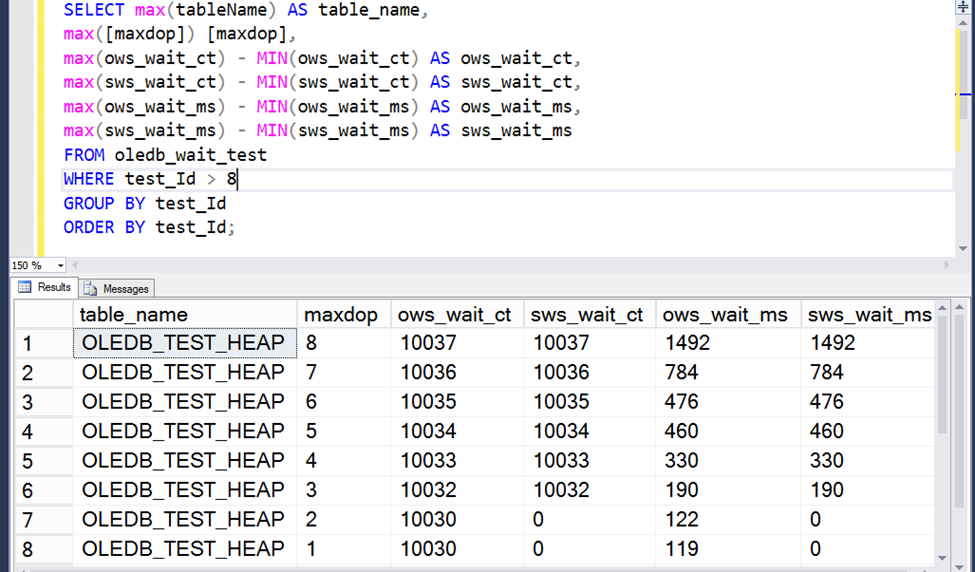Since I plan to do a lot of testing, create a table to store some test definitions and results.
DROP TABLE IF EXISTS oledb_wait_test; CREATE TABLE oledb_wait_test (test_id INT, captured NVARCHAR(256), capture_time DATETIME, spid INT, tableName NVARCHAR(256), [maxdop] INT, physicalonly NVARCHAR(1), [tablock] NVARCHAR(1), wait_type NVARCHAR(256), ows_wait_ct BIGINT, ows_wait_ms BIGINT, sws_wait_ct BIGINT, sws_wait_ms BIGINT CONSTRAINT pk_oledb_wait_test PRIMARY KEY CLUSTERED (test_id, captured)) WITH (data_compression = page);
OK. Let's create a very basic heap to submit to checktable operations.
CREATE TABLE OLEDB_TEST_HEAP ([num] BIGINT, [str] NVARCHAR(4000)); DECLARE @str NVARCHAR(max); SET @str = REPLICATE ('A', 4000); /*for 80 * 80 = 6400 rows OLEDB_TEST_HEAP will allow parallel checktable with physical_only for 79 * 79 = 6249 rows OLEDB_TEST_HEAP will only run checktable with physical_only in serial */ ;WITH cnum(num) AS (SELECT TOP (80) 1 FROM sys.columns) INSERT INTO OLEDB_TEST_HEAP SELECT row_number() OVER (ORDER BY (SELECT NULL)), @str FROM cnum c1 CROSS JOIN cnum c2;
Its really, really easy for me to skip a detail like coalescing NULL values in wait tables to zero in order to get valid deltas... so lets encapsulate the test and results capture in a stored procedure.
Here's my simple stored procedure:
- take parameters for a checktable operation
- record the parameters and tare OLEDB wait values from system and session levels
- execute dynamic SQL for checktable operation
- record system and session level OLEDB wait values after checktable completion
CREATE OR ALTER PROCEDURE CHECKTABLE_OLEDB_WAIT_TEST (@tableName NVARCHAR(256), @MAXDOP INT = 8, @PhysicalOnly NVARCHAR(1) = 'Y', @TABLOCK NVARCHAR(1) = 'N') AS DECLARE @dynSQL NVARCHAR(1000); DECLARE @testID INT; SELECT @testID = COALESCE(max(test_Id), 0) + 1 FROM oledb_wait_test; SET @dynSQL = N'DBCC CHECKTABLE ([' + @tableName + ']) WITH MAXDOP = ' + CONVERT(NVARCHAR(2), @MAXDOP) + CASE WHEN @PhysicalOnly = N'Y' THEN N', PHYSICAL_ONLY' ELSE '' END + CASE WHEN @TABLOCK = N'Y' THEN N', TABLOCK' ELSE '' END + ';'; INSERT INTO oledb_wait_test SELECT @testId AS test_Id, 'BEFORE' AS captured, getdate() AS capture_time, @@spid AS spid, @tableName AS tableName, @MAXDOP AS [maxdop], @PhysicalOnly AS physicalonly, @TABLOCK AS [tablock], ows.wait_type AS wait_type, COALESCE(ows.waiting_tasks_count, 0) AS ows_wait_ct, COALESCE(ows.wait_time_ms, 0) AS ows_wait_ms, COALESCE(sws.waiting_tasks_count, 0) AS sws_wait_ct, COALESCE(sws.wait_time_ms, 0) AS sws_wait_ms FROM sys.dm_os_wait_stats ows LEFT OUTER JOIN sys.dm_exec_session_wait_stats sws ON sws.wait_type = ows.wait_type AND sws.session_id = @@spid WHERE ows.wait_type = 'OLEDB'; EXEC (@dynSQL); INSERT INTO oledb_wait_test SELECT @testId AS test_Id, 'AFTER' AS captured, getdate() AS capture_time, @@spid AS spid, @tableName AS tableName, @MAXDOP AS [maxdop], @PhysicalOnly AS physicalonly, @TABLOCK AS [tablock], ows.wait_type AS wait_type, COALESCE(ows.waiting_tasks_count, 0) AS ows_wait_ct, COALESCE(ows.wait_time_ms, 0) AS ows_wait_ms, COALESCE(sws.waiting_tasks_count, 0) AS sws_wait_ct, COALESCE(sws.wait_time_ms, 0) AS sws_wait_ms FROM sys.dm_os_wait_stats ows LEFT OUTER JOIN sys.dm_exec_session_wait_stats sws ON sws.wait_type = ows.wait_type AND sws.session_id = @@spid WHERE ows.wait_type = 'OLEDB';
All right. Let's run 8 tests - from MAXDOP 8 in decreasing order to MAXDOP 1.
EXEC CHECKTABLE_OLEDB_WAIT_TEST @tableName = N'OLEDB_TEST_HEAP', @MAXDOP = 8, @PhysicalOnly = 'Y', @TABLOCK = 'N'; EXEC CHECKTABLE_OLEDB_WAIT_TEST @tableName = N'OLEDB_TEST_HEAP', @MAXDOP = 7, @PhysicalOnly = 'Y', @TABLOCK = 'N'; EXEC CHECKTABLE_OLEDB_WAIT_TEST @tableName = N'OLEDB_TEST_HEAP', @MAXDOP = 6, @PhysicalOnly = 'Y', @TABLOCK = 'N'; EXEC CHECKTABLE_OLEDB_WAIT_TEST @tableName = N'OLEDB_TEST_HEAP', @MAXDOP = 5, @PhysicalOnly = 'Y', @TABLOCK = 'N'; EXEC CHECKTABLE_OLEDB_WAIT_TEST @tableName = N'OLEDB_TEST_HEAP', @MAXDOP = 4, @PhysicalOnly = 'Y', @TABLOCK = 'N'; EXEC CHECKTABLE_OLEDB_WAIT_TEST @tableName = N'OLEDB_TEST_HEAP', @MAXDOP = 3, @PhysicalOnly = 'Y', @TABLOCK = 'N'; EXEC CHECKTABLE_OLEDB_WAIT_TEST @tableName = N'OLEDB_TEST_HEAP', @MAXDOP = 2, @PhysicalOnly = 'Y', @TABLOCK = 'N'; EXEC CHECKTABLE_OLEDB_WAIT_TEST @tableName = N'OLEDB_TEST_HEAP', @MAXDOP = 1, @PhysicalOnly = 'Y', @TABLOCK = 'N';
And what was captured for OLEDB wait stats during each checktable?
They say a picture is worth a thousand words...
OLEDB wait count at the system level ranged from 6428 at maxdop 1 and maxdop 2 up to 6435 at maxdop 8. Interesting. The table OLEDB_TEST_HEAP was constructed with 80 * 80 = 6400 rows, each of which are expected to consume an 8k block (because of the 4000 character NVARCHAR and the lack of compression on the table). Since these results are from physical_only tests, could the number of waits be related to the number of blocks in the heap?
That seems plausible.
Let's resize OLEDB_TEST_HEAP to 10000 rows and see what happens.
TRUNCATE TABLE OLEDB_TEST_HEAP; DECLARE @str NVARCHAR(max); SET @str = REPLICATE ('A', 4000); ;WITH cnum(num) AS (SELECT TOP (100) 1 FROM sys.columns) INSERT INTO OLEDB_TEST_HEAP SELECT row_number() OVER (ORDER BY (SELECT NULL)), @str FROM cnum c1 CROSS JOIN cnum c2;
Now run the same tests as above, with maxdop decreasing from 8 to 1, and display the results captured. Interesting. Very interesting.
So... yeah. Definitely a relationship between the number of pages in the heap and the number of OLEDB waits. Something(s) increase the number of OLEDB waits beyond the number of data pages, the number of used pages and the number of reserved pages in a way that I haven't deciphered yet, though.
One thing is clear - above maxdop 2, one OLEDB wait is added for each incremental increase in maxdop. That's interesting. Another interesting point: at maxdop 2 and maxdop 1 the number of OLEDB system waits are equal rather than decreasing again by 1. Hmmm.
And the most interesting thing: at maxdop 2 and maxdop 1, the session OLEDB waits seem not to update.
I created a connect item for the OLEDB wait disappearing act in the session wait DMV sys.dm_exec_session_wait_stats. The repro in this blog post is better than the one I put in the details of that connect item :-) I'll update the connect item later.
OLEDB waits not always updating in sys.dm_exec_session_waits
https://connect.microsoft.com/SQLServer/feedback/details/3135073
There's more to come as I continue to look at OLEDB wait behavior in checktable operations...
[
carry on with this epic saga here...
OLEDB waits in #SQLServer Checktable Part II - the song remains very nearly the same
http://sql-sasquatch.blogspot.com/2017/06/oledb-waits-in-sqlserver-checktable_5.html]




No comments:
Post a Comment